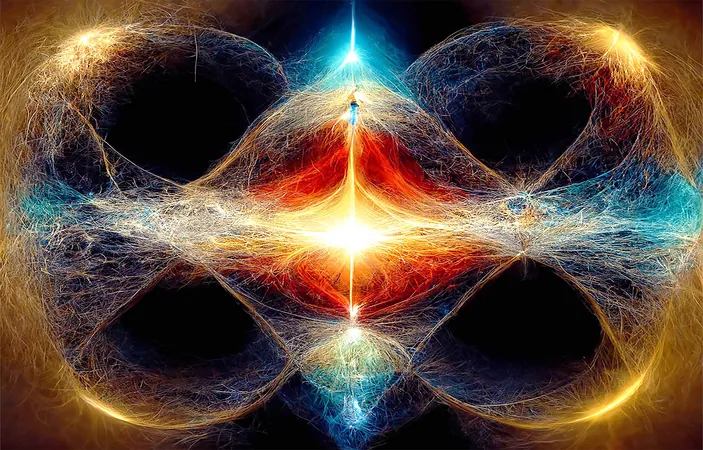
Is Consciousness Everywhere? The Surging Theory of Panpsychism
2025-05-20
Author: Kai
Unlocking the Mystery of Consciousness
Consciousness has long been viewed as a uniquely human trait, tied closely to brain activity and behavior. However, thinkers throughout history have posited a radical idea: what if consciousness extends far beyond human experiences and permeates the very fabric of material existence? This concept—panpsychism—suggests that every particle in the universe harbors a sliver of consciousness, no matter how faint.
A Historical Perspective on Consciousness
The inquiry into the nature of consciousness dates back to ancient philosophers. In the 6th century B.C., Thales of Miletus mused that magnets must possess a soul due to their ability to move iron. His successor, Anaxagoras, proposed that all things contain a fragment of mind, a precursor to modern theories about collective consciousness arising from individual micro-experiences.
Throughout history, various thinkers—like the Greek Stoics, Plotinus in late antiquity, and Renaissance philosopher Giordano Bruno—reflected on the interconnectedness of the universe and the idea that all matter is alive in some capacity.
From Dualism to Integration: The Enlightenment's Shift
The Enlightenment marked a turning point when René Descartes famously separated mind from matter, relegating consciousness to an immaterial realm. Yet, philosophers like Gottfried Wilhelm Leibniz countered this by proposing 'monads,' small units embodying their unique perceptions of the universe.
By the late 19th century, thinkers such as William James and Alfred North Whitehead revived the conversation, suggesting consciousness could be ingrained within nature itself. With Charles Darwin's insights into evolution, the notion emerged that consciousness could evolve gradually, potentially existing in various forms across the spectrum of matter.
Modern Neuroscience Meets Ancient Philosophy
Today, contemporary neuroscientists are actively probing the enigma of consciousness. Researcher Giulio Tononi at the University of Wisconsin has developed Integrated Information Theory (IIT), which proposes that consciousness correlates with the amount of integrated information a system produces, indicated by the value 'Φ.' High levels of Φ signify a rich, coherent experience, while low levels suggest a more muted awareness.
IIT is groundbreaking as it asserts that consciousness is intrinsic and can emerge from any sufficiently complex structure—be it biological brains, artificial intelligence, or, theoretically, even a simple silicon block.
Linking Consciousness to Quantum Mechanics
The quest to understand consciousness has even ventured into quantum mechanics. Physicist Roger Penrose and anesthesiologist Stuart Hameroff propose the Orchestrated Objective Reduction (Orch-OR) theory, which speculates that quantum processes within neuronal microtubules lead to moments of awareness. Although some biophysicists challenge this idea, pointing out the conditions necessary for quantum coherence, ongoing research into quantum phenomena in biological systems keeps the theory alive.
The Philosophical Implications of Panpsychism
While some critics fear that attributing consciousness to atoms diminishes the complexity of human experience, proponents highlight an intriguing aspect known as the 'combination problem.' If subatomic particles possess minuscule feelings, how do these myriad subtleties coalesce into the robust consciousness we exhibit? Despite the lack of a consensus solution, the idea refuses to fade.
Panpsychism offers a viable alternative to dualism, supporting the notion that consciousness could be a fundamental part of the universe's makeup rather than an exterior attachment.
Looking Ahead: The Future of Consciousness Studies
As research advances, the exploration of consciousness faces new challenges and opportunities. Neuroscientists are refining metrics based on Ψ, while physicists pursue quantum links in biological contexts. Philosophers too are reevaluating age-old concepts through the lens of modern discourse.
Regardless of where this journey leads, it confronts us with a profound possibility: consciousness might not be the exclusive domain of living beings but rather a simplistic note in the cosmic symphony. The task ahead could shift to deciphering how diverse experiences—from the simplest to the most complex—harmonize into the vibrant reality we know.


 Brasil (PT)
Brasil (PT)
 Canada (EN)
Canada (EN)
 Chile (ES)
Chile (ES)
 Česko (CS)
Česko (CS)
 대한민국 (KO)
대한민국 (KO)
 España (ES)
España (ES)
 France (FR)
France (FR)
 Hong Kong (EN)
Hong Kong (EN)
 Italia (IT)
Italia (IT)
 日本 (JA)
日本 (JA)
 Magyarország (HU)
Magyarország (HU)
 Norge (NO)
Norge (NO)
 Polska (PL)
Polska (PL)
 Schweiz (DE)
Schweiz (DE)
 Singapore (EN)
Singapore (EN)
 Sverige (SV)
Sverige (SV)
 Suomi (FI)
Suomi (FI)
 Türkiye (TR)
Türkiye (TR)
 الإمارات العربية المتحدة (AR)
الإمارات العربية المتحدة (AR)